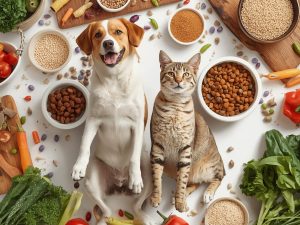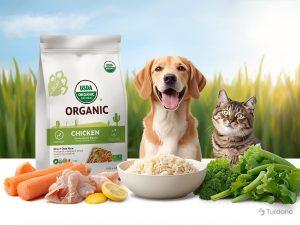I’ve always subscribed to the idea that what we ingest matters. The same applies to our pets. When I first discovered an organic option in pet food, I was hesitant to try it because I didn’t know if it was some marketing gimmick or a real way to enhance the lives of my pets. Besides, my dog has happily wolfed down random crumbs off the floor — how much can “organic” really matter? But curiosity (and a dash of guilt) propelled me to find out more. Over time, what I found is that animal organic diets are not about spoiling the animals with gourmet food; they’re about cleaner, safer nutrition.
In this guide, I will cover what they are so you can decide whether or not organic meals are worth it for your furry friend:

🦴 What You’ll Learn in This Guide
- What “organic” truly means in pet nutrition.
- How it differs from natural (or regular) versions.
- The actual pros and cons.
- What kinds there are and how to use labels.
- Why it’s more expensive and whether it’s worth the splurge.
- How to read packaging and not be misled.
- If homemade organic meals are plausible.
- FAQ’s to address common questions.
So, why don’t we begin with some of the fundamentals (but no worries — I’ll take it nice and easy, sans confusing jargon).
🥕What Does ‘Organic’ Really Mean for Pet Food?
If you see the word “organic” printed on a bag of kibble, it isn’t just for show. In the U.S., it represents adherence to USDA regulations. That means:
- No Pesticides, No Chemical Fertilizers, No GMOs!
- Meat is from animals raised humanely, without antibiotics or growth hormones.
- At least 95 percent of the ingredients meet these requirements for the food to bear the USDA Organic seal.
In short: organic food is not only about nutrition, it’s also a matter of how ingredients are farmed and handled.
And no, it’s not because someone massaged the carrots before they went into the bag.

🌿Organic vs. Natural vs. Regular Pet Food: What’s Best for Your Pets?
I used to have a friend who insisted she was feeding her dog “organic” food. The label, it turns out, only said “natural.” This happens a lot. So here’s my explanation of the difference:
Type | Description
Organic → Certified, non-pesticide, hormone-free with strict regulations.
Natural → No artificial flavors, colors, or preservatives but may still be grown with pesticides.
Regular → Pet food of the standard variety stocked in most stores. Safe and sane, but not necessarily chemical-free.
🐕 Benefits of Choosing Organic Meals
Look at it this way: natural food is a step up from regular, but organic takes matters further with more exacting farming and processing guidelines.
- Benefits of Choosing Organic Meals
- So, why bother? Here is what I and many pet owners perceive:
- Cleaner diet. Less chemical residue translates into weaker long-term health risks.
- Digestive ease. Some pets also experience fewer stomach upsets when they’re enjoying clean meals.
- Better coat and skin. Lots of owners say their dogs’ fur is shinier and that they have fewer allergic reactions.
- Overall wellness. Pets may appear to have more energy and stability.
Of course, let’s not exaggerate. An organic meal isn’t going to make your lazy cat into a marathon runner or turn your intractable dog into a polite gentleman. But in the long-term, perhaps they can help your partner to flourish.
🥩 Varieties of Organic Pet Food
Here is what is out there on the market.
- 100% Organic → True treasure, typically very costly and clearly marked.
- Organic (95%) → The most popular, also meets USDA standards.
- Made with Organic Ingredients (70%) → Still controlled, but not allowed to use the USDA seal.
Format ranges from dry kibble to canned meals, raw freeze-dried diets, and yes, even snacks. If pressed, I used dry food because my cats don’t mind it and because it doesn’t require the kitchen equivalent of a trip to Futurama and back in order to dispose of it.PrettyFood (2)Myself, I began with dry food as an expediency; however, I know people who make bitter ends for canned foods for that “fresher” feel.

🥩How to Read Labels (Without Being Misled)
Pet food packaging can be the marketing equivalent of green design — leaves, farms, sunshine. Don’t get distracted. Here’s what matters:
- Look for the USDA seal if you’re in the U.S. Other countries have similar certifications.
- Look at the first ingredients. You’re after good-quality proteins (chicken, salmon and lamb) rather than fillers.
- Ignore meaningless claims. “Premium,” “gourmet” and “holistic” have no legal weight.
And if you’d like to ensure your pet’s diet is as comfortable, have a look at how I compared the pet cave dog bed. nutrition plus good sleep = happy animal, after all.
Is Organic Always Better?
Here’s the truth part of it (I think): not always.
A properly balanced conventional recipe that meets AAFCO standards can be just as nutritious. Your dog or cat will not be missing any vital nutrients just because the food isn’t organic.
The distinction is cleaner sourcing and fewer chemical residues. It’s not about “better nutrition” so much as shielding from unwanted substances. And for some owners, that peace of mind is priceless. For others, the price is simply a little too high to afford regular food.
- Why It Costs More
- The elephant in the room? Price.
- Organic food prices are usually 30–50% higher than those of their conventional counterparts. The reasons are straightforward:
- Organic farming is labor-intensive.
Farmers do not receive the same subsidies that conventional ones do.
Smaller farm scale means less efficiency in ramping up production.
The good news? Some owners consider it an investment. Spend more now, and possibly save in vet bills later. You know, provided your wallet doesn’t object.
Should You Go for Homemade Organic Meals?
I’ve experimented with this. It can be rewarding to put home-cooked, organic meals on the table, but it’s hard not to fall into nutritional traps along the way. For instance, cats require taurine (an amino acid) and dogs need the right balance of calcium to phosphorus.
- If you’re considering homemade:
- Ask your vet before transitioning.
- Stick to approved recipes, not just what “sounds healthy.”
- Use supplements when necessary.
- It can work, but it must be guided. Otherwise, you risk nutritional gaps.
- Going to and From Home With Your Pet Safely
So if you do make the switch, transition slowly. Add a small amount of the new food to the old and gradually increase over 7-10 days.
Immediate changes in diet may disturb sensitive stomachs. Believe me — you don’t want to clean up after that mess.
Budget-Friendly Tips
Organic diets are expensive. Here are some of the ways I’ve found to save:
- Purchase in Large Quantities from reputable outlets.
- Alternate meals. * Add some organic kibble to normal wet food.
- If too expensive, replace full diets with organic treats.
- That way, you’re still reducing your chemical exposure without going completely broke.
Real-Life Example
One of my clients went from regular dry to natural organic for her Labrador. “In three weeks I saw his scratching diminished, his coat was shinier and he seemed to have more energy.
Another friend attempted organic food for her cat. nothing dramatic except the cat wouldn’t touch it. (So with it, yes, your pet’s taste buds may trump your pocketbook and your principles.)
FAQs
“Does organic pet food really benefit my pets?”
Not necessarily. It decreases chemical exposure but doesn’t promise better nutrition.
Is it safe to feed young animals organic diets?
Yes, as long the food is marked for their growth stage.
Is grain-free the same thing?
No. Grain-free is about the kind of carbs you use, not how those ingredients are produced.
How can I tell if it’s certified?
Seek official seals, such as USDA or EU Organic.
What if I can’t go whole organic?
Mix it up. Organic treats, or partially lifting your meal plan also helps.
Will organic food cure allergies?
Not necessarily, but it can alleviate some triggers from additives or chemicals.
Final Thoughts
Going organic for me is not about luxury — it’s about minimizing the chemicals used in my pets’ diets. Does it mean every dog or cat needs it? No. Will it make some pets feel better and live healthier? Absolutely.
At the end of the day, your decision boils down to your price range, what your furry little buddy requires and how much peace of mind is worth to you. If you do, gradually work up to it, and see how you feel.
And never forget that whether your dog is eating organic kibble or stealing fries off your plate, it thrives on love and care. (But by all means, sit on the chocolate.)
